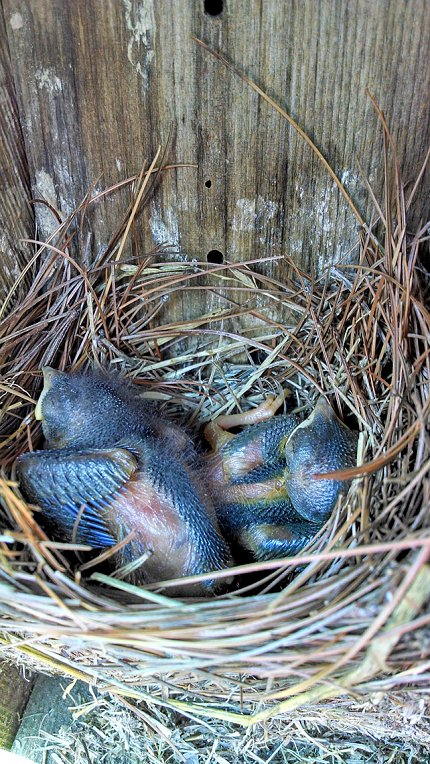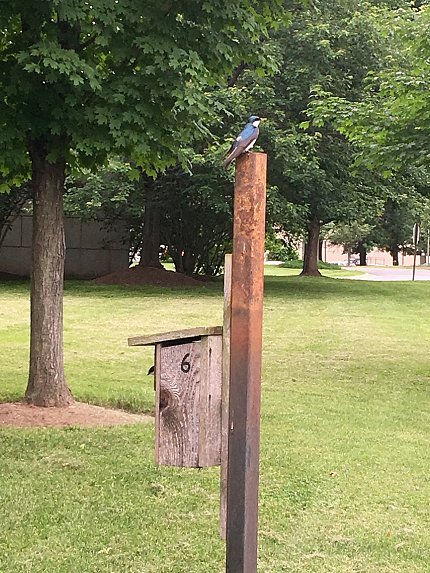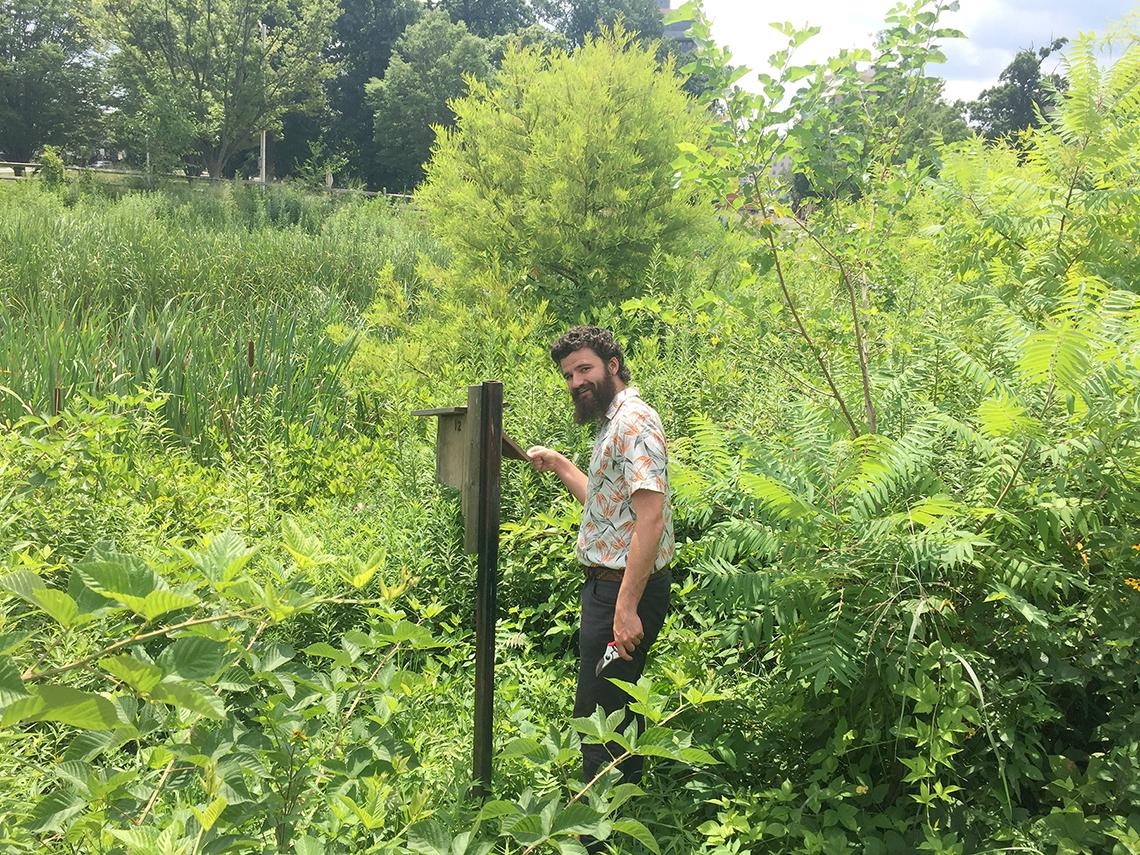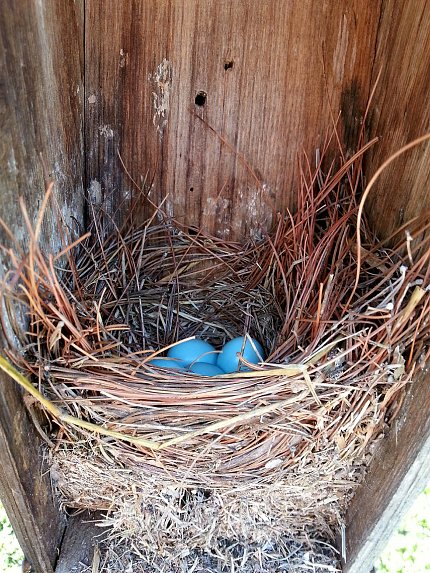2018 Census Complete
Bluebirds Make a Comeback

Photo: Jennifer Watson
Numbers have been crunched and the tallies have been totaled. With all the data now in, the verdict is clear: NIH’s homesteader bluebirds (and other mosquito-eaters) have rebounded, after a noticeable 5-year absence.
“I’m proud to reveal that we were able to fledge six bluebirds this year!” announced Brandon Hartz, NIH landscape architect, in a recent note to birdhouse monitors. “Now, that’s not a very high number but according to…past statistics, the last time we had bluebirds fledge on campus was 2013.”
That’s good news for the Office of Research Facilities’ effort to control the Bethesda campus’s pests without spraying insecticides. The idea, the brainchild of Hartz’s predecessor Lynn Mueller, was to attract small birds (and bats) whose natural diet included mosquitoes and other potential disease-carrying insects.
The novel solution to pest control began more than 18 years ago, in spring 2001, when NIH grounds maintenance crews installed more than 30 birdhouses and several bat houses in strategic locations throughout the property. In the year or so before then, reports surfaced of the possibility of West Nile virus potentially threatening the campus and vicinity via the warm weather mosquito population. Mueller and company sought to head off any such invasion.
In the nearly two decades since, the avian housing project has mostly thrived, attracting a variety of enthusiastic pest eaters.
In addition to bluebirds, “we had the usual suspects show up again this year—chickadees, wrens and tree swallows,” Hartz reported. “In total, we had 166 desirable native cavity-nesting birds fledge out of the 99 boxes on the 8 trails in Bethesda. The number of boxes is down a bit because of ongoing construction. I’m hopeful we can get some new boxes put up before next year’s season, if those construction projects finish up over the winter.”

Photo: Haluk Resat
After the 33 houses put up that first season, more have been added over time, peaking at 106 in 2015. The year before had seen a sizable influx of wrens and chickadees. Top years for bluebirds taking up residence were 2005-2006 and 2011-2012.
Unfortunately, Hartz pointed out, the bird bungalows have also caught the attention of less-desirable tenants—house sparrows. The bigger, more aggressive birds bully the mosquito eaters and take over the nesting sites. Even the normally mild-mannered tree swallows have been known to be confrontational, though, chasing off Hartz and crew a time or two when the humans ventured a little too close to the birds’ temporary quarters.
It’s the Circle of Life, of course, for the sparrows to go after the smaller birds, but predator fowl thwart the mosquito-combat strategy. Hartz and his crew have been forced to try and block out larger birds by narrowing the house entrances with mesh and wire.
“As a ratio of fledgling to box, the campus saw 1.5 fledglings for every box,” Hartz said. “Fifteen years ago in 2003, for comparison, we had just over one fledgling per box. So we are housing more birds than in the past. The biggest change noticeable in the past 15 years has been the shift in nesting species from bluebird to tree swallow.”
A longtime lead designer of outdoor sustainable environments who earned his master’s degree in landscape architecture at Harvard, Hartz employs methods that naturally fit NIH. He takes time to collect information, study conditions from several angles and then draw data-driven conclusions.
“Looking at the previous years’ data, as well as some visuals that help to show this species shift,” he explained in his update to birdwatchers, “one has to conclude that the increasing developmental footprint and squeezing out of green space is having a major effect on the wildlife on the Bethesda campus. For comparison, Poolesville, which is basically open pastureland, has only 55 boxes but fledged a whopping 72 bluebirds!”

Photo: Brandon Hartz
Hartz’s note also acknowledged “an information gap in 2016 to 2017.” That’s when Mueller retired in late 2015 and the position was vacant for a while before Hartz joined and learned the birdhouse ropes.
Now that the project is picking up speed again, recruitment is underway for more folks to help monitor the houses regularly. About 20 volunteers from all across campus walk the 8 trails, usually in duos, checking on nesting habits, noting bird residents and sometimes even capturing snapshots of wildlife.

Photo: Janet Gamson
Several NIH’ers are long-time veteran monitors: The two longest-tenured bluebird box volunteers are Michael Bopf and Mary Herron, both of NLM. Bopf started in 2006; Herron’s been at it since 2007. NIH retiree Dr. John Newman, now an NICHD volunteer, monitors bird boxes on NIH’s farm up in Poolesville.
Hartz, along with summer intern Alexander Mueller (yep, that Mueller—“A.J.” is following in dad’s footsteps, literally), made up another team of regular Bethesda monitors this past season. Still, it would help with data collection to add a few more next spring, so that vacations, scheduling conflicts and other breaks in service are covered.
“I so very much appreciate all of the time and effort that you all put in on a volunteer basis,” Hartz said in the email report to monitors. “Ideally, these numbers will help us do an analysis to see where we’re having success and where we’re not, which specific trails are attracting the birds we want and which houses may need to be moved to better locations.”
Email brandon.hartz@nih.gov at any time, if you want to volunteer or learn more about requirements for monitoring.
